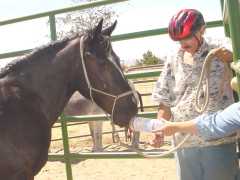|
Training Approaches Used
Only "low resistance" training approaches will be permitted with these animals.
Mechanical or "artificial" restraints are not appropriate. "Approach and retreat,"
and similar interactive methods will be employed, such as those taught at the Wild
Horse Workshops.
In situations where a "safe squeeze" may be needed to halter or provide veterinary
care to an ungentled horse, Mike Horrigan's "approach and retreat in the squeeze"
approach will be used so as not to disturb the horse.
Interacting with the animals, as opposed to forcing them to comply, is the most
humane approach. Furthermore these approaches serve to lessen the animals'
anxieties about people. Once they learn that people are OK, then these horses will
not be stressed over the crowds at the Olympics, even though they will have just
been gentled a short while.
The volunteer Wild Horse Mentors will be the primarily ones gentling, handling
and training the animals. Thus this project will have educational value.
|
Mike Kerson clicker training Dusty in Knightsen

Shellie Demone and Gator in Lancaster

|